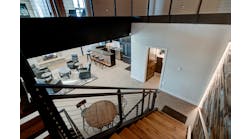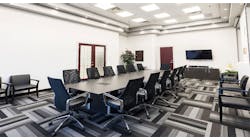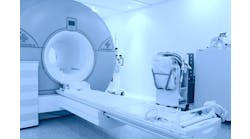Traditionally, large ultraviolet (UV) disinfection water treatment plants take about four years to design, build, and commission. One of the largest UV plants in North America, however, was recently completed in just 27 months due to an aggressive, fast-track schedule and a design-build approach.
“The design-build approach allowed us to work together with the client from the conceptual stage of the project all the way to completion,” says Brendan Andrews, electrical engineer with Stantec, the company that provided the architectural, civil, structural, mechanical, and electrical engineering services on the project. “It is very cost effective to be able to get going on construction while we are still progressing on design.”
The San Francisco Public Utilities Commission hired PCL Construction, Inc., a general contracting firm with offices in Phoenix, Tampa, Fla., and Los Angeles, to construct the Tesla Water Treatment Plant, which serves more than 3.5 million people in the San Francisco metropolitan area. PCL then partnered with Stantec and Rosendin Electric to construct the facility, which treats 315 million gallons of water per day.
When the team members first arrived on the construction site, they discovered a small amount of aging treatment equipment, including a small valve shed, pumping facility, chlorination building, and caretaker residence. While the workers didn’t need to remove any structures, they decommissioned most of the older equipment once the newer devices were up and running. During construction, however, the electricians kept the older equipment in operation so as not to interrupt existing service to its customer base.
“That equipment had been operating for a number of years, and it had its own electrical service,” Andrews says. “When we constructed the new facility, it was easy to maintain the operation of this equipment and then tie it into the new facility once we were ready.”
Overcoming obstacles. While numerous other water treatment plants nationwide are using UV disinfection technology, the Tesla water treatment facility differs from many of these other facilities because of its immense size. The team had to order large, custom-built reactors that could handle the massive volume of water that required treatment. They then needed to test the equipment to ensure it met the regulatory requirements for disinfection.
The size of the equipment also affected the design of the structures on site. Normally, a team would construct a building first and then deliver the equipment. In the case of the Tesla facility, however, the workers installed the majority of the piping first and then constructed the buildings around it.
Overall, the buildings span more than 20,000 sq ft, which includes a 10,000-sq-ft chemical storage building and a 2,400-sq-ft operations and lab building; the remaining space is used for UV reactors, electrical switchgear, control systems equipment, on-site generators, carbon dioxide tanks, UPS systems, and site piping and valves.
Although the project required a unique approach to design, the firms were able to circumvent any challenges with PCL’s extensive background in constructing sophisticated structures and Rosendin Electric’s ability to quickly respond to changes in the field.
“PCL’s design-build team provided Stantec with their input, and then together, we determined the most cost- and time-effective way to build the facility,” Andrews says. “Maintaining open lines of communication with our experienced construction partners produced a coordinated, cooperative effort.”
Providing reliable power. As part of the project, the team constructed two main structures — an operations building and a UV building. The main electrical system starts at the 10,000-sq-ft UV building and is subsequently distributed to the 2,400-sq-ft operations building, which comprises a laboratory, boardroom, and administrative area. The team also constructed several other systems and buildings, which are sub-fed from the main electrical building, including a valve chamber area and a chemical building where disinfecting chemicals are injected into the water supply.
Within the main UV building, the workers installed 12 banks of 200kW-rated UV reactors for a total of 2,400kW. The majority of the load on the site is dedicated to the UV disinfection equipment. To power the plant, the electrical workers routed a 12kV service overhead across part of the property. Once the overhead service reached the developed site, the workers transitioned it to an underground service leading to a 2,500kVA step-down transformer and eventually into a main electrical room containing metal-enclosed switchgear and other equipment.
In addition to installing typical power distribution equipment, the firms also had to devise a plan to maintain power to the UV disinfection equipment in the event of an outage, which was deemed to be a critical system.
“The UV disinfection system needs to stay online at all times,” Andrews says. “We installed three 1,200kVA-rated flywheel UPS units in parallel so that, when there is an outage on the electric utility feed, the UPS units would be capable of providing sufficient power to maintain the UV reactors online while the plant’s standby generators started. The system also provides momentary paralleling with the utility, allowing for a seamless transfer of power when the utility feed is restored.”
Conserving energy. Energy efficiency also played a key part in the Tesla project. The facility not only achieved a LEED Silver rating, but also exceeded the Title 24 code set forth by the California Energy Commission. To achieve this designation, the workers installed approximately 35kW of solar panels on top of the UV building and equipped the buildings with energy-efficient lighting.
For example, the electricians from Rosendin Electric illuminated the interior of the buildings with high-efficiency fluorescent lighting and the exterior with compact fluorescent lighting and metal-halide lighting. To reduce light pollution, the electricians installed full cutoff fixtures. To minimize energy usage, they installed programmable lighting controls, occupancy sensors, astronomical time clocks, and photocell devices. The architects incorporated a significant amount of natural daylighting in the building design to reduce the lighting load requirements during the day.
“We minimized the number of lighting fixtures and used a lot of daylighting in the facility,” Andrews says. “We wanted the building to exceed Title 24 requirements, and we ended up being about 15% better, which was very exciting.”
Despite the complex nature of the project and the strict energy-efficiency requirements, the team managed to keep the project on track through good planning and communication. Also, Stantec drew upon its resources all across North America to deliver the job on time and on schedule.
“Our partners were able to help us identify a lot of the construction issues before it got to that point in the field. That proved key to maintaining such an aggressive schedule,” Andrews says.
Fischbach is a contributing writer based in Overland Park, Kansas. She can be reached at [email protected].


